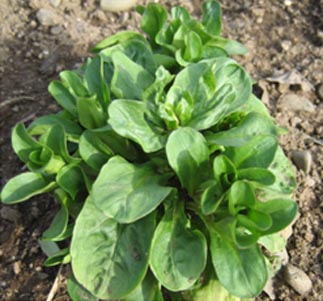Lamb's lettuce Nutrition facts
Lamb's lettuce (Mâche in French) is a tender salad green with smooth, rounded leaves. The tender, velvety, spoon-shaped leaves that grow in rosettes have a gentle tangy, nutty flavor.
Scientific name: Valerianella locusta. Genus: Valeriana. Lamb's lettuce does not actually belong to the lettuce family but is a member of Caprifoliaceae (honeysuckle), a family of dicotyledonous flowering plants.
 |
| Lamb's lettuce,-Valerianella locusta. |
Corn salad, field salad, nut lettuce are some of the common names of this salad green. It is known as lamb's lettuce for its resemblance to a lamb's tongue.
Lamb's lettuce is an annual dicotyledon plant, that probably originated in the Mediterranean region. It is a small herbaceous hardy plant growing profusely in a wide range of soils.
The plant prefers full sun. It grows very low to a height of about 15 cm height and spread of 15 cm in a rosette fashion, connected by individual, long, delicate stems.
If left to grow, tiny, lilac-blue flowers appear in small umbels. Harvesting is usually attempted before flowering, 40-55 days after seedling.
Health Benefits of Lamb's Lettuce (Mache)
Lamb's lettuce is a storehouse for many phytonutrients that have health promotion and disease prevention properties.
3.5 Oz (100g) fresh leaves carry just 16 calories). Also, its leaves hold a good amount of roughage. Dieticians often recommend these leafy greens in cholesterol-controlling and weight-reduction programs.
Fresh leaves are a rich source of several vital antioxidant vitamins like vitamin A, vitamin C, and flavonoid polyphenolic antioxidants such as lutein, zeaxanthin, and β-carotene. Together, these compounds help act as protective scavengers against oxygen-derived free radicals and reactive oxygen species (ROS) that play a healing role in aging and various disease processes.
Zeaxanthin, an important dietary carotenoid, is selectively absorbed into the retinal macula lutea in the eyes where it is thought to provide antioxidant and protective UV light-filtering functions. It thus helps protect from "age-related macular related macular disease" (ARMD), especially in older adults.
Lamb's lettuce is an excellent source of vitamin-K. 100 g of fresh greens provides 41% of daily requirements of this vitamin. Vitamin K plays a vital role in strengthening bone mass by promoting osteoblastic activity in the bones. Additionally, it also has an established role in patients with Alzheimer's disease by limiting neuronal damage in the brain.
This green leafy vegetable also contains good amounts of many B-complex vitamins such as vitamin-B6 (pyridoxine), thiamin (vitamin B-1), riboflavin, folates, and niacin. Folates help prevent neural tube defects in newborns.
Lamb's lettuce leaves contain small amounts of vitamin C. Vitamin C is a powerful antioxidant, which helps the body develop resistance against infectious agents and scavenge harmful oxygen-free radicals.
Its leaves also contain a good amount of minerals like potassium, manganese, magnesium, copper and zinc. Potassium is an important component of cells and body fluids that helps control heart rate and blood pressure. The human body uses manganese and copper as a co-factor for the antioxidant enzyme, superoxide dismutase. Copper is also required for the production of red blood cells. Zinc is a co-factor for many enzymes that regulate growth and development, digestion, and nucleic acid synthesis.
Consumption of lamb's lettuce in the diet helps prevent osteoporosis (weakness of bones), iron-deficiency anemia.
Moreover, its soft leaves are believed to protect the human body from cardiovascular diseases and cancers of the colon and prostate.
| Principle | Nutrient Value | Percent of RDA |
|---|---|---|
| Energy | 16 Kcal | 1% |
| Carbohydrates | 0.5 g | 0.4% |
| Protein | 2 g | 3.6% |
| Total Fat | <0.5 g | <2.5% |
| Cholesterol | 0 mg | 0% |
| Dietary Fiber | 2.3 g | 6% |
| Vitamins | ||
| Folates | 45.5 µg | 11.5% |
| Niacin | 0.37 mg | 2% |
| Pantothenic acid | 0.25 mg | 5% |
| Pyridoxine | 0.096 mg | 7% |
| Riboflavin | 0.066 mg | 5% |
| Thiamin | 0.042 mg | 3.5% |
| Vitamin C | 2.38 mg | 2.5% |
| Vitamin E-α | 0.22 mg | 1.5% |
| Vitamin K | 48.9 µg | 41% |
| Electrolytes | ||
| Sodium | <5 mg | <1% |
| Potassium | 330 mg | 7% |
| Minerals | ||
| Calcium | 41 mg | 4% |
| Copper | 0.1 mg | 9% |
| Iron | 0.4 mg | 5% |
| Magnesium | 19 mg | 5% |
| Manganese | 0.28 mg | 12% |
| Phosphorus | 30 mg | 4% |
| Zinc | 0.14 mg | 1.2% |
| Phyto-nutrients | ||
| Carotene-ß | 3280 µg | -- |
Buying
Greenhouse-grown Lamb's lettuce (mâche) is available year-round. Field-grown green is often found in specialty stores and farmer's markets. Lamb's lettuce is at its best from May to November.
Lamb's lettuce is usually sold in small bunches, with its root still attached, and often as a mixed salad green (mesclun).
Look for bright lively green, velvety leaves. Most American mâche is greenhouse-grown, imported from Holland. Choose fresh, green, springy, and glistening leaves.
Avoid limp leaves that have lost some of their green and show yellow discoloration.
Storage
Lambs' lettuce spoils quickly if not handled well. Use it soon after the purchase. If not, store wrapped in a paper towel, then place in a loosely closed or perforated plastic bag in the refrigerator for 1 to 2 days.
Preparation and serving methods
Lamb's lettuce is very tender and delicate tasting. Prepare, and trim rootlets if any. Just before serving time, wash gently by swishing in cold water, changing the water if necessary. Do not soak leaves. Pat dry leaves carefully.
Its spoon-shaped leaves have an excellent nutty flavor that goes well with other mild-tasting leaves. For better flavor, season them only at the time of serving.
These greens are best suited for raw applications in salads and as a garnishing, although they are often braised in light sauces or steamed.
Do not use vegetables or vinaigrette with an overly strong flavor, so that its mild flavor is not masked.
Nut oil with lemon juice and salt will bring out its delicate taste.
Here are some serving tips:
 |
| Lamb's lettuce over Lemon Sole and bruschetta. Courtesy: Luca Sbardella |
Lamb's lettuce is delicious by itself, in a salad with nuts, apples, or beets or combined with tender butter-lettuce. These leafy vegetables add a distinctive, tangy flavor to salads.
It can be used as a garnish in soup. for this purpose, chop finely and add at the end of cooking.
It adds colors to omelets, potato salads, and rice dishes.
It can be incorporated into poultry stuffing.
Use cooked greens in recipes that call for spinach.
Safety profile
Lamb's lettuce is low-oxalate content leafy-greens which makes it a suitable substitute for other greens like spinach. (Medical disclaimer).
Also read ≻≻-
≻≻- Stem-lettuce (Celtuce) nutrition facts.
≻≻- Lettuce nutrition facts.
≻≻- Iceberg lettuce nutrition facts.
≻≻- Stinging nettle nutrition facts.
≻≻-Back to Vegetables from Lamb's lettuce. Visit here for an impressive list of vegetables with complete illustrations of their nutrition facts and health benefits.
≻≻-Back to Home page.
Further Resources:
Mache (Valerianella locusta)-UC Master Gardener Program of Sonoma County. (Link opens in new window).